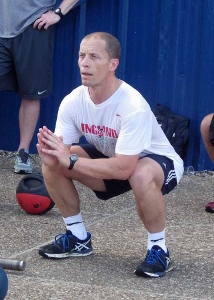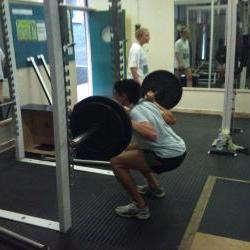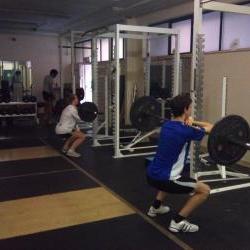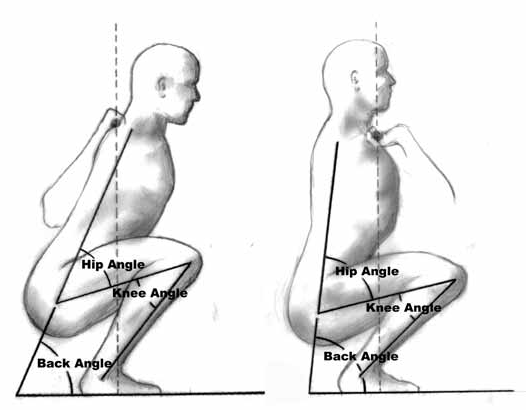Front Squat vs Back Squat: which is better?
Squatting is essential for female athletes
 Assistant coach Fran Low was an experienced hockey player when she started working with Excelsior. However, she had never done squats. Part of her role was to research front squat vs back squats. Here are the results:
Assistant coach Fran Low was an experienced hockey player when she started working with Excelsior. However, she had never done squats. Part of her role was to research front squat vs back squats. Here are the results:
Unlike most males who spend many hours swanning around the weights in the gym, the squat was a relatively new and daunting exercise to me.
Having not spent much time strength training (reasons highlighted in this piece about females in the gym) I was unaware of the importance of the squatting movement and how it underpins most strength training exercises.

Body weight squat
I realised the true importance of squatting during the first few seconds of my first session with James. If you cannot squat correctly then don’t even think about lifting any weights!
I wanted to learn how to squat properly.This article aims to highlight details and techniques of the front and back squats as well as looking at the power ratios between the different exercises.
(James’ note N.B. before attempting to load with a barbell, make sure you can do body weight squats properly:
Back Squats:
It is one of the only exercises that directly trains hip drive (the initial movement out of the bottom of a full squat is hip drive).
Hip drive is important for any sport that involves running, jumping or lunging (so most sports really!).
The squat uses the whole of the so called posterior chain, that is the calves, hamstrings and glutes working together. Due to the large range of movement, the squat is very effective at synchronising and enhancing this movement.
It works the whole body requiring stabilising muscles to be trained as well as the gross muscle groups.
It also replicates a movement used in everyday life and most sports.
Variations:
- Back squat: Barbell rests on the back of the shoulder, more info below
- Front Squat: Barbell rests on the front of the shoulders, more info below.
- Overhead squat: a squat performed with a weight/item (barbell, medicine ball, dumbbell, broomstick) above the head.
- Hindu Squat: body weight exercise, squatting down onto toes, bringing heels to bum, and swinging arms down, straightening legs standing up and pushing from the toes.

bar too high
Back Squat Technique:
- Approach bar in either power or squat rack.
- Grasp bar using a pronated grip (width dependant on placement on back).
- Stand upright with the bar resting across the upper back (supported by 1 or 2 spotters, if required).
- Feet width self-selected, but no wider than shoulder-width.
- Elbows high and as far forward as possible, to support bar.
- Prior to descent, take a breath and hold it.
- Bend slowly at the knees and hips.
- Maintain a flat back throughout the descent.
- Keep heels on the floor and do not allow the body to fall forward.
- Try to keep the knee in line with the toe (don’t allow knees to buckle, this leads to injury!).
- Stop descent at an appropriate depth for the athlete, ideally when legs are/past parallel to the floor.
- Without bouncing raise the bar by extending hips and knees.
- Keep back flat and head up.
- Keep hips under the bar.
- Hold breath through sticking point*.
- At the completion of the set walk forward and replace bar in stands.
Back Squat – The good vs. bad
| Pros | Cons |
| Total body workout | Cannot perform with back problems |
| Improve posture and balance
Trains the posterior chain |
Can be dangerous if an incorrect technique
Squats can be uncomfortable |
| Trains stabilizing muscles leading to reduced risk of injury | |
| Build Muscle/gain strength | |
| Improve/maintain flexibility | |
| Used to exercise everything from endurance to power |
 Front Squats:
Front Squats:
This movement is more upright and so places a more direct workload on your quads. You won’t be able to lift as much weight as in the back version, though.
This key difference is highlighted in an image below and due to the greater hip angle, reduces the useof the hamstrings in the movement.
This means it does not activate the posterior chain and although good for working the quadriceps, can neglect the hamstrings. For this reason, it is not advised to solely use the front squat in training.
Front Squat Technique:
Same as back squat although instead of having bar placed on the back of shoulders it is placed on the front of the shoulders:
- Keep elbows high (upper-arm, almost parallel to the floor) and chest up.
- Your shoulders support the weight, not your hands. Open your hands, relax them. Two/Three fingers under the bar is suggested.
- Perform same squatting action as the back squat; however you will find that your back will stay straight as you need to keep your chest out to balance.
Front Squat – The Good vs. the Bad
| Pros | Cons |
| Requires/helps flexibility | Max front squat will be lighter than max Back squat. |
| Harder to ‘cheat’ | Does not target the hamstrings and glutes unlike the back squat. |
| Build Muscle/gain strength | Often Limited by stabiliser muscle flexibility rather than quadriceps fatigue (wrists, shoulders, ankles). |
| More emphasis on quadriceps | Does not train the posterior chain |
| Can improve other lifts | |
| Considered safer than the back squat |
How I earnt how to squat properly
The best way to gain a true understanding of these two squats is to try them yourself! So that’s what I did….
Firstly I would say I felt more comfortable and stable during the front squat. I was able to squat lower. However, my wrists did begin to ache, suggesting that I should work on wrist flexibility!
I could lift heavier with the back squat but I also felt more wobbly! The key coaching point I took from James was “Sit down”. Everything else is very technical, but to get started that simple cue was the best.
Overview
There are many differences between the two squatting techniques which this article has aimed to highlight. To sum it all up it is evident that the back squat should be an exercise in every athlete’s repertoire.
To help with the back squat technique you can use the front squat, however don’t rely solely on the front squat as you will be neglecting the hamstrings and it isn’t as possible to lift as much weight.
Good coaching is essential for both types of the squat.
- Learn how to coach the squat on one of our courses
- Or join our Weight Lifting Club in Devon
Happy Squatting!
Fran Low
*Sticking point – The most difficult part of a lift, i.e. when the bar will not go any higher.


Thanks Fran, I would also add that the Front squat is great preparation for the clean. It is important to get a full range of motion before loading: the diagrams illustrate this well.
It is also very important for female athletes to get good at squatting. Too many girls go “jogging” or do “agility” without a sound strength base and efficient mechanics.
Squats help with both of these.
In reference of the q angle in female athletes would you suggest any changes to technique i.e a wider stance or ten to two foot placement?
Regards
JJ
Nope.
Back squat – no. 14 -on the ascent keep hips under bar before sticking point? really?
Thanks for the comments, with reagrds to the wider stance or different foot placement for females, they don’t run with a wider stance or different foot placement,so we shouldnt load them like this.
Hope that helps,
Cheers
Fran
You have as a con of the front squat “does not train posterior chain”, it does of course train this, just with less emphasis than the olympic or pl back squat. If looking at Olympic lifters in the front squat they are of course wearing shoes which are wedges which is considerably different to running trainers.
As the comment below says the hips cannot be under the bar in the back squat, perhaps you mean drive the hips forward? I use FS or box squat with our players the box squat teaches sitting back, gives consistency and control.
I thought it was a nice breakdown of the different squats. Adam and I got into a big discussion on which one is the best. He is a big proponent of using front squats because they are safer; he argues it forces you to stay in a safer position. I am not sold on one being better than the other. I really like the challenge to stability and the back position in the front squat; I also like it because so many sports are played with the load out in front of the body. I like that you can load the back squat much more, and it is easier to keep the weight over your hips. I am not sure if I would agree with your intern about the front squat not training the posterior chain. On the whole, I really think that he did an excellent job.
Andy Stone
Hi,
thanks for all the comments: please leave a name so we know who you are.
I think “posterior chain as much” is probably more accurate.
Point 14- is a bit ambiguous too I agree, but as a coaching point I find it helps the athlete drive upwards, rather than do a straight dead leg lift followed by a reverse good morning.
But that is a coaching discussion- not a technical one. It doesn’t matter what cues you give- if the athlete can understand and squats well. That will be different for every athlete in front of you. That is not assessed at certain certifications where you have to recite a series of technical points whilst doing the lift yourself!
Prefer the front squats much more!
dom
[…] heavy for longer. Do big lifts, under loads, for some time. Strongman training, deadlifts, squats are all good ways of gaining mass. If it is just pure mass, with little function, then you are […]
[…] from movement screening to dumbbell exercises and barbell exercises (especially squats and deadlifts). We moved outside to do agility training (hip projection being key) and finally […]
[…] training working on hip drive and hamstring strength and knee and hip stability will aid running efficiency and also reduce the […]
[…] the exercises used are heavy multi joint exercises such as squats, leg presses for legs benches & inclines for chest overhead presses for shoulders etc […]
[…] number of body weight for juniors, a loaded variant (back, front, overhead) for experienced […]